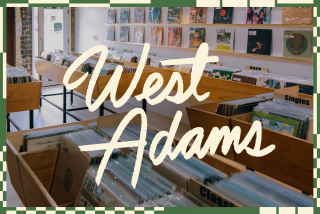Rivalry runs deep along the Thames
- Share via
LONDON — John Adams slept here.
As ambassador to the Court of St. James’s from the newly born United States of America, the future president took up residence on Grosvenor Square in London’s fashionable Mayfair district, an easy walk to the bespoke tailors on Savile Row and the royal residence at Buckingham Palace. The move launched an American presence on the square, north of the River Thames, that has lasted more than 200 years.
Not for much longer. Last month, the U.S. Embassy announced that, partly for security reasons, it was going to pull up stakes from one of London’s smartest enclaves in exchange for a diplomatic compound to be built in the Nine Elms neighborhood just two miles away, as the crow flies.
That crow, however, would be flying across the Thames to London’s south side, and therein lies the rub. As any resident will tell you, the river is more than just a physical divide between the British capital’s upper and lower halves; it’s a psychological and social one as well.
As I discovered even before moving here recently, which side of the Thames you live on truly puts you on the map -- not just the indispensable A-Z street guide found in every household, but the mental atlas Londoners consult to locate you on the spectrum of sass and class. Your address lands you on one side of a geographical rivalry that’s full of pride and prejudice.
The north is, without doubt, classic London, home to Buckingham Palace, the houses of Parliament, Hyde Park and long-established, phenomenally expensive enclaves with names like Belgravia, Mayfair and Kensington. You can hardly walk a block without spotting a circular blue plaque marking the building where some historically significant politician, inventor or poet once lived. The city’s theater district, museums, concert halls, posh restaurants and shopping meccas such as Harrods lie in the north.
Ask a north Londoner about the other side of the Thames, and he may well sniff that it’s “a bit common, really.” One blog describes south London as the “wasteland where plague victims were buried,” adding, “Very little has changed.”
Not surprisingly, southerners don’t take kindly to such superior sighs. They see their northern neighbors as snobs too stuffy to appreciate the merits of south London, which may lack Old World elegance but buzzes with the energy and edge that a new wave of residents has brought in.
More affordable home prices have led to a recent boom in the south’s popularity among yuppies, whose demand for cafes, bars and clubs is being eagerly catered to. So many young families have nested in Clapham, a charming neighborhood of Victorian-era terraced houses -- this counts as “new” in Britain -- that locals call the area “Nappy Valley,” a reference to the high diaper count.
During my own search for a flat, it wasn’t hard to find pros and cons to both north and south, just as there are on either side of the 405 Freeway in Los Angeles. Andrew Duncan, a local historian, thinks the Thames divide is overrated.
“The river is always going to be a practical physical division between the two,” he said, “and it’s going to have some symbolic significance because of that.”
But, he added, “I’ve lived in London 25 years. I don’t think it’s ever been a really huge issue.”
He clearly hasn’t talked to my real estate agents and London friends who insist that their side of the Thames is the only game in town.
While I was deciding where to live, one friend signed off almost every e-mail with the reminder that “north of the river is best!” At the same time, a pal in the south warned only half-jokingly that if I chose to live on the opposite side, he probably would visit me less often than when I lived in India.
For a more studied opinion, I turned to Time Out magazine, which issued a verdict on the rivalry three years ago. The winner: south London by a whisker, though the magazine’s categories of comparison, including which side was home to the most “pointless celebrity” and which owned the most interesting world record, weren’t necessarily ones I found useful.
History and infrastructure are largely to blame for the bad rap the south has long received from the north.
The heart of the city traditionally beat in the north, where the royal court lived; the south was much later to develop. Until the mid-18th century, in all of London there was only one bridge across the Thames, Duncan said.
The city’s subway system, the Underground, runs almost entirely beneath the north, further reinforcing the belief of some north Londoners that they inhabit the center of the universe.
“It’s so far to where you are,” one woman complained to an acquaintance in the south who wanted to get together. “Why don’t you come here?”
The tug of war and the antagonism across the river won’t end any time soon, and Londoners, an opinionated bunch, will no doubt continue to vote with their feet.
The U.S. Embassy is doing just that with its eventual move to Nine Elms, which lies close to Vauxhall, a well-known enclave fast becoming a gay hot spot. The present ambassador, Robert H. Tuttle, said that the U.S. was happy to contribute to the exciting regeneration of the south side.
But one of the best things about the new site, according to another U.S. official? The views of the north.
--
More to Read
Sign up for Essential California
The most important California stories and recommendations in your inbox every morning.
You may occasionally receive promotional content from the Los Angeles Times.









